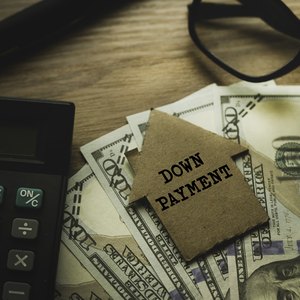
Homeownership is a major goal for many families, but coming up with the amount of money required for the down payment to qualify for a home loan can be a huge obstacle.
Let's look at the average down payments that homeowners are making and the types of loans that have low minimum down payment requirements.
What is a Down Payment?
When you buy a new home, lenders usually require you to make a down payment. These down payment amounts can range from three percent up to 20 percent or more. However, there are a few loans where you can purchase a house with zero down payment.
Let's say, for example, you're considering the purchase of a house for $300,000. If the lender requires a 10 percent down payment, you would need to have $30,000 in cash available at the time of closing. In addition, you would also likely need cash to pay closing costs, which can run from three to five percent of the mortgage amount.
Read More: The Pros and Cons of Mortgages
What is the Average Down Payment?
You'll hear many things during the home buying process. You'll hear that the ideal down payment on a house is 20 percent of the purchase price. However, in reality, very few people actually put down that much. According to Forbes, the average down payment for most buyers is 12 percent. Repeat buyers with equity from their previous homes make average down payments of 16 percent, and first-time home buyers put down an average of 7 percent.
What is the Minimum Down Payment Required?
The minimum down payment depends on the type of loan you're applying for. You can put down as little as 3 percent with the HomeReady mortgage from Fannie Mae and the Home Possible mortgage from Freddie Mac. The type of mortgage in these programs require credit scores of at least 680 and above.
Down payments for loans from the Federal Housing Administration, or FHA loans, are based on your credit score. If you have a credit score over 580, you’ll only have to put down 3.5 percent upfront. However, if your score is less than 580, you’ll need to make a down payment of at least 10 percent. Under FHA rules, the seller can pay closing costs, so you don't necessarily need the cash to pay for these fees.
Read More: What is the Average Mortgage Payment?
Loan Programs with Zero Down Payments
There are a couple of government-sponsored programs that don't require any down payment.
Veterans Administration loans with zero down payment are available to current and past members of the military and their surviving spouses. Although the VA doesn’t have a minimum credit score requirement, lenders for VA loans generally prefer minimum FICO credit scores from 580 to 660 and a debt-to-income ratio of no more than 41 percent. Buyers with higher credit scores will get better rates.
The United States Department of Agriculture (USDA) offers loans with zero down payments for home buyers with modest incomes when buying houses in certain designated rural areas. In addition to no down payments, the program offers mortgages with below-market rates and reduced mortgage insurance premiums.
The USDA defines a rural area as one with a population of less than 20,000. The buyer's income is limited to no more than 15 percent above the median income for the area and a minimum FICO credit score of at least 640.
How Much Down Payment Should You Make?
The amount of a down payment you make is a personal decision based on your financial resources and your desired use of funds.
The biggest advantage of making a larger down payment is that it lowers your monthly mortgage payment. Let's suppose that you're thinking about purchasing a house for $300,000, and you can either put 5 percent down or 20 percent down. With a 5 percent down payment, your mortgage amount will be $285,000 ($300,000 less $15,000). If you put 20 percent down, your mortgage loan will be $240,000 ($300,000 less $60,000).
For simplicity, let's assume the interest rate in both cases will be 4 percent for 30 years. With 5 percent down, your monthly payment would be $1,361. A 20 percent down payment would give you a monthly payment of $1,146. Your monthly payment would be $215 less with a 20 percent down payment.
The next advantage of a larger down payment is not having to pay private mortgage insurance. Making a 20 percent down payment eliminates the need for private mortgage insurance, which can add a few hundred dollars to your monthly mortgage payment. According to Rocket Mortgage, PMI can range from 0.5 to 1 percent of the mortgage amount.
The good news is that when your home’s value rises and your loan-to-value ratio decreases to 80 percent, you can request the lender to remove the PMI. Legally, a lender is required to remove the PMI payment when your loan-to-value ratio declines to 78 percent.
However, making a larger down payment has consequences::
- It’ll take longer to save up the down payment to buy a home.
- You’ll have less money in the form of cash after closing to fix up your new place.
- You could risk depleting your emergency fund or savings account.
Another advantage is that sellers will find your offer more attractive if it includes a higher down payment with the financing. Buyers that make larger down payments are more likely to have their loans approved, reducing the risk to the seller of the buyer's offer not going through because of lack of financing. Sellers are more willing to accept offers at lower prices from these types of buyers because lenders are more likely to approve their loan applications.
Down Payment Assistance for Homebuyers
Down payment assistance for homebuyers is available from many state and local organizations. There are over 2,500 down payment assistance programs that offer loans to help with down payments; some are interest-free and even forgivable.
These programs won't work for everyone. You'll still need to show a steady job, decent income and an above-average credit score. These programs are designed for someone who needs help with a down payment, not someone with bad credit.
The three major types of down payment assistance program are:
- Interest-bearing loans secured by a second mortgage that must be repaid
- Interest-free loans also secured by a second mortgage and must be repaid but at no cost
- Grants which the homebuyer doesn’t have to repay
Some programs have forgivable loans. The borrower doesn't have to pay back these types of loans if they occupy the home for a specific period of time.
Down payment assistance loans have limits. Some programs, for example, will only advance up to 5 percent of the home purchase price, so the borrower should still be prepared to come up with some cash.
Not having a large down payment doesn't mean you can't buy a house. However, you do need a decent credit score and steady income to receive a good interest rate and be able to handle the monthly payments.
References
- Zillow: How Much Is a Down Payment on a House?
- TheMortgageReports: The Average Down Payment On a House & When to Put Down More or Less Money
- Forbes: How Big Should Your Down Payment Be?
- TheStreet: How Much is a Down Payment on a House? Do You Need 20 Percent?
- The Mortgage Reports: First-time Home Buyer Down Payments Start at Just 3%
- The Motley Fool: Here’s What Americans Are Putting as Down Payments for Their Homes and Why It’s Not Enough
- RocketMortgage: What Is PMI? Private Mortgage Insurance Defined And Explained
- TheMortgageReports: USDA Home Loans: USDA Loan Requirements & Rates For 2021
Writer Bio
James Woodruff has been a management consultant to more than 1,000 small businesses. As a senior management consultant and owner, he used his technical expertise to conduct an analysis of a company's operational, financial and business management issues. James has been writing business and finance related topics for work.chron, bizfluent.com, smallbusiness.chron.com and e-commerce websites since 2007. He graduated from Georgia Tech with a Bachelor of Mechanical Engineering and received an MBA from Columbia University.

